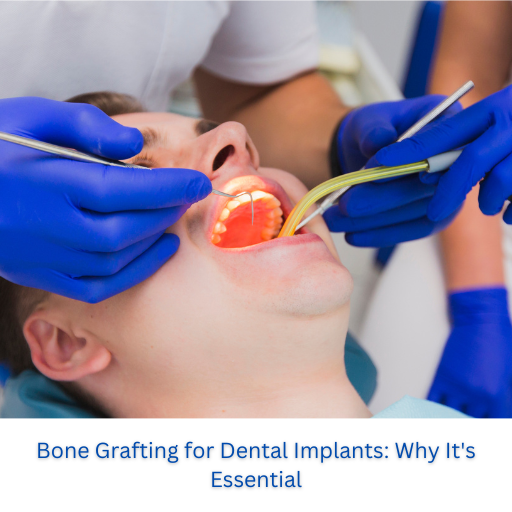
Welcome to the ultimate guide on the significance of bone grafting for dental implants. If you’re considering dental implants or want to enhance your knowledge about this essential procedure, you’ve come to the right place. We’ll delve into why bone grafting is crucial, providing insights, answering your questions, and shedding light on its importance for a successful dental implant journey.
Dental implants have revolutionized the world of dentistry, offering a durable and natural-looking solution for individuals with missing teeth. However, the success of dental implants hinges on a solid foundation, and this is where bone grafting plays a pivotal role. Without sufficient bone density in the jaw, dental implants may not securely integrate, potentially leading to complications down the road. In this comprehensive guide, we’ll explore the intricate relationship between bone grafting and dental implants, ensuring you have all the information needed to make informed decisions about your oral health. It’s a bridge to a brighter smile and improved quality of life. Beyond the technical aspects, it’s a journey towards renewed confidence in your appearance and the ability to enjoy your favorite foods without worry. Throughout this guide, we will demystify the bone grafting process, address common concerns, and provide a clear understanding of why it’s a cornerstone in the realm of dental implants. So, whether you’re contemplating dental implants for the first time or seeking to deepen your understanding, join us on this educational voyage to discover why bone grafting is an essential step towards a more vibrant smile and a healthier you.
Summary:
1. The Basics of Bone Grafting
2. Understanding Bone Grafting
6. Bone Grafting: The Procedure
1. The Basics of Bone Grafting
Bone grafting serves as the foundation for successful dental implant surgery. Here, we’ll explore the fundamentals of this essential procedure, setting the stage for a deeper understanding. Bone grafting is a surgical technique designed to address a common challenge in dental implantology—insufficient bone density. This lack of bone density often occurs due to factors such as tooth loss, gum disease, or natural bone resorption over time. Without an ample foundation, the success and longevity of dental implants are jeopardized. Bone grafting tackles this issue head-on by introducing additional bone material into the jaw, effectively fortifying the weakened area. This newly added bone tissue not only creates a more robust base for implant placement but also facilitates the integration of implants with the surrounding bone, ensuring they become a stable and permanent part of your dental structure. Bone grafting lays the groundwork for a healthier, more confident you. It’s a meticulous process, performed by skilled dental professionals, tailored to your specific needs. As we journey through this guide, we’ll delve deeper into the types of graft materials, the surgical procedure itself, and the benefits that arise from this crucial step. Understanding the fundamentals of bone grafting is the first step towards comprehending its vital role in the world of dental implants. So, let’s continue our exploration, unraveling the intricacies of this transformative procedure.
2. Understanding Bone Grafting
Bone grafting is a surgical technique that involves the transplantation of bone tissue to repair and strengthen the jawbone. This process is vital when the jaw lacks sufficient bone density to support dental implants.
Bone grafting emerges as a transformative procedure, akin to the construction of a strong and sturdy scaffold within your jaw. This surgical technique is a precise artistry that addresses a common challenge – the inadequate bone density required to support dental implants effectively. When natural teeth are lost or damaged due to factors like decay, injury, or gum disease, the surrounding jawbone can gradually lose its density over time. This loss can be a significant obstacle for those seeking dental implants, as these artificial teeth replacements rely on a stable and robust foundation for long-term success. Enter bone grafting, a remarkable process that orchestrates the transplantation of bone tissue from one part of your body to another or from a donor source to your jaw. This transplantation is meticulously designed to repair and strengthen the jawbone, offering a renewed opportunity for individuals with compromised bone density. Whether you’re considering single-tooth implants, implant-supported bridges, or full-mouth restorations, bone grafting plays a pivotal role in making these transformative treatments possible. It’s not just about repairing bones; it’s about restoring lives and smiles, one graft at a time. In the sections ahead, we’ll delve deeper into the mechanics of bone grafting and why it’s the bedrock upon which dental implant success is built.
3. Ensuring Stability
Adequate bone density ensures the stability of dental implants. Without a strong foundation, implants may not integrate properly with the jawbone, leading to potential complications.
Picture dental implants as the architectural marvels of modern dentistry, meticulously designed to replicate the form and function of natural teeth. To achieve this level of realism and longevity, they require an unwavering support system. This support system is none other than your jawbone, serving as the bedrock on which your new teeth are anchored. Adequate bone density within the jaw is the linchpin in this intricate balance. It acts as the cornerstone of stability, ensuring that the implants become fully integrated with your bone structure.
Without sufficient bone density, dental implants face a significant hurdle. They may struggle to secure a firm grip within the jaw, leading to potential complications down the road. These complications can manifest as implants that become loose, fail to osseointegrate (meaning they don’t fuse with the bone as intended), or even result in discomfort and an imperfect fit. In essence, a strong foundation is the key to a successful dental implant journey. It’s the assurance that your new teeth will not only look and feel natural but will also stand the test of time. In the following sections, we’ll further explore how bone grafting plays a pivotal role in establishing this essential foundation.
4. Enhanced Aesthetics
Bone grafting can significantly improve the aesthetics of your smile. It allows for the placement of implants in the ideal position, resulting in a more natural and appealing appearance.
When it comes to your smile, aesthetics matter. Your teeth play a central role in your overall facial appearance, and any irregularities can impact your self-confidence and how others perceive you. This is where the artistry of bone grafting comes into play. By bolstering the jawbone’s strength and density, bone grafting provides a solid canvas upon which your dental implants are positioned. This strategic placement isn’t just about functional alignment; it’s about creating a symphony of aesthetics.
Bone grafting allows dental professionals to precisely position your implants, ensuring that they harmonize seamlessly with your natural teeth. This means that your new teeth not only function like real ones but also mimic their appearance. The result is a smile that’s not just restored but enhanced. It’s a smile that radiates confidence, as no one can discern the difference between your dental implants and your natural teeth. As we delve deeper into the world of bone grafting, you’ll discover how this procedure contributes to the artistic and aesthetic aspects of your dental implant journey.
5. Avoiding Complications
Insufficient bone density can lead to complications such as implant failure or a less secure fit. Bone grafting mitigates these risks, ensuring a smoother and more successful implant procedure.
The road to dental implant success is not always a smooth one, especially when the foundation, your jawbone, is not in optimal condition. When there’s a deficiency in bone density, the risks of complications loom large. One such risk is implant failure, a situation where the artificial tooth, despite being surgically placed, fails to integrate with the jawbone as intended. This can be not only disappointing but also financially and emotionally burdensome. Additionally, a less secure fit can result in discomfort, improper bite alignment, and potential damage to adjacent teeth.
Fortunately, bone grafting steps in as the hero of this narrative. By augmenting the jawbone with additional bone material, bone grafting addresses the root cause of these complications. It strengthens the foundation, creating an environment where dental implants can thrive. This meticulous procedure significantly reduces the risk of implant failure and ensures a snug, secure fit for your new teeth. It’s a proactive approach that guarantees a smoother and more successful implant procedure, sparing you from the pitfalls of insufficient bone density. In the upcoming sections, we’ll delve into the intricacies of bone grafting, revealing how it acts as a shield against these potential complications.
6. Bone Grafting: The Procedure
- Consultation and Evaluation: Before the surgery, your dentist will conduct a thorough evaluation to determine the extent of bone grafting required. This personalized approach ensures the best possible outcome. This initial phase is where your dentist carefully assesses your unique oral condition. It’s not a one-size-fits-all approach but a personalized examination that considers your specific needs and circumstances. During this comprehensive evaluation, your dentist will take into account factors such as the current state of your jawbone, the number of implants needed, and the quality of your oral health. This thorough assessment lays the foundation for a tailored bone grafting strategy, ensuring that the upcoming procedure is precisely calibrated to achieve the best possible outcome. This personalized approach is the hallmark of responsible dental care. It ensures that you receive the exact level of bone grafting necessary to restore your oral health and support your dental implants. No excess or insufficient grafting material will be used, and every step of the process is fine-tuned to align with your unique circumstances. The result is a treatment plan that maximizes the chances of success and minimizes any potential complications. As we continue to explore the world of bone grafting, you’ll gain a deeper understanding of how this meticulous evaluation process paves the way for a successful and customized dental implant journey.
- Graft Material Options: There are various graft materials available, including autografts, allografts, and xenografts. Your dentist will select the most suitable option based on your specific needs. Selecting the right graft material is a critical decision in the bone grafting process. Different individuals have unique requirements, and their suitability for specific graft materials depends on a variety of factors. Here, we explore the three primary graft material options: autografts, allografts, and xenografts.
- Surgical Process: During the surgery, the chosen graft material is placed in the targeted area of the jawbone. Over time, this material fuses with your existing bone, creating a strong and stable foundation for the implant. The surgical phase of bone grafting is where the intricate transformation of your jawbone begins. This procedure typically takes place in a sterile environment, ensuring the utmost safety and precision. It commences with your dentist or oral surgeon making a small incision at the predetermined site in your jaw where additional bone density is needed. This site is often strategically chosen based on the specific requirements of your dental implant treatment plan. The chosen graft material, whether it’s an autograft, allograft, or xenograft, is then carefully positioned in the targeted area. It acts as a scaffold, providing support and structure while your natural bone regenerates. Over time, a remarkable process called “osseointegration” occurs. This is where the graft material fuses with your existing bone, gradually becoming a seamless part of your jaw. This fusion is what ultimately creates a strong and stable foundation for the implant that will follow. In essence, the surgical process is the catalyst that sets in motion the transformation of your jawbone, paving the way for a successful dental implant procedure.
FAQs about Bone Grafting
Q. Is bone grafting a painful procedure?
A. No, bone grafting is typically performed under anesthesia, ensuring a pain-free experience. Discomfort during the recovery period is manageable with medication.
Q. How long does the bone grafting process take?
A. The procedure itself usually takes a few hours, but complete integration of the graft with your jawbone may take several months.
Q. Are there any risks associated with bone grafting?
A. Like any surgical procedure, there are risks, but they are minimal. Your dentist will discuss these with you during the consultation.
Q. Can anyone undergo bone grafting for dental implants?
A. In most cases, yes. However, individual factors and medical history may affect candidacy. Consult with your dentist to determine if you’re a suitable candidate.
Q. How much does bone grafting cost?
A. The cost varies depending on the type of graft material used and the complexity of the procedure. Your dentist will provide a detailed cost estimate during the consultation.
Q. Is bone grafting covered by dental insurance?
A. In some cases, dental insurance may cover a portion of the cost. Check with your insurance provider for specific details.
Conclusion
bone grafting stands as the linchpin of triumph in the realm of dental implant procedures, offering individuals grappling with missing teeth the prospect of a revitalized and confident smile. Beyond its functional significance, bone grafting significantly enhances aesthetics, fosters stability, and acts as a proactive shield against potential complications. This procedure, characterized by meticulous evaluation and personalized approaches, presents an array of graft material options to suit individual needs. It serves as the essential conduit for the seamless integration of dental implants, not only revitalizing teeth but also instilling self-assurance and elevating the overall quality of life. Whether you’re embarking on your first steps towards dental implants or seeking a deeper understanding, remember that bone grafting is the foundational support that ensures your path to oral health is solid and enduring.
For a comprehensive and in-depth exploration of this subject, we encourage you to visit our website at https://premierperiodonticspa.com/ Our website offers a wealth of extensive resources that can further enrich your understanding of crown lengthening and related topics. If you have specific inquiries or need personalized assistance, please do not hesitate to contact us at (267) 908-4867. Our dedicated team is readily available to provide you with the information and support you may require. Please feel free to reach out, and we would be delighted to assist you.









